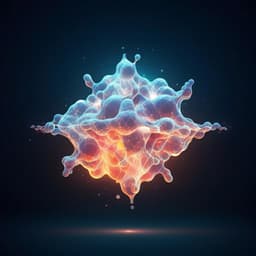
Chemistry
H₂-driven biocatalysis for flavin-dependent ene-reduction in a continuous closed-loop flow system utilizing H₂ from water electrolysis
G. Lim, D. Calabrese, et al.
Discover the groundbreaking research conducted by Guiyeoul Lim, Donato Calabrese, Allison Wolder, Paul R. F. Cordero, Dörte Rother, Florian F. Mulks, Caroline E. Paul, and Lars Lauterbach on a scalable electro-driven flow system, leveraging immobilized enzymes for superior flavin-dependent biocatalysis. This innovative approach showcases notable efficiency in converting ketoisophorone to levodione, promising a sustainable solution for fine chemical synthesis.
~3 min • Beginner • English
Introduction
The study addresses the challenge of scaling efficient, green biocatalytic processes for fine chemicals, focusing on continuous flow systems that capitalize on enzyme selectivity under mild conditions. Ene-reduction of activated C=C bonds by Old Yellow Enzyme (OYE) flavoproteins is a valuable route to generate stereogenic centers, but cofactor regeneration is often a bottleneck. While NAD(P)H is the common reductant for enzyme-bound FMN, alternative reductants including reduced free flavins have emerged, prompting interest in flavin-based biocatalysis for reductions, epoxidations, hydroxylations, and nitro reductions due to the low cost of flavins compared to NAD(P)H. Prior photochemical and electrochemical methods for flavin regeneration have suffered from low conversion and stability. In vivo OYE flow biocatalysis can achieve high conversions but complicates downstream processing. The authors propose an in vitro, closed-loop, electro-driven flow platform that uses H₂ as a clean reductant (generated from water electrolysis) to regenerate FMNH₂ via a soluble hydrogenase, aiming to deliver high conversion, robustness, and scalability while simplifying product isolation.
Literature Review
- Continuous flow biocatalysis offers improved control, reduced waste, and energy efficiency, and recent advances in flow chemistry and enzyme immobilization have increased feasibility for fine chemicals.
- OYE-catalyzed asymmetric reductions of α,β-unsaturated carbonyls rely on FMN cofactors; alternative hydride/electron sources for OYEs and flavin recycling have been explored.
- Flavin-based catalysis is attractive beyond ene-reduction (e.g., epoxidation, hydroxylation, nitro reductions), but photochemical/electrochemical flavin regeneration can suffer from low rates and stability.
- Prior in vivo continuous-flow OYE applications achieved high conversions but introduced downstream processing challenges.
- Soluble [NiFe]-hydrogenase (SH) from Cupriavidus necator can oxidize H₂ to reduce NAD⁺/NADP⁺ and also reduce free flavins (FMN/FAD), offering atom-efficient cofactor regeneration; SH shows high specific activity for FMN reduction compared to Hyd1.
- Water electrolysis using PEM electrolyzers provides pure H₂ with high efficiency and operational advantages (high current densities, rapid response), and gas-permeable membrane-based gas addition (e.g., tube-in-tube) enables efficient gas-to-liquid transfer in flow chemistry.
- Previous electro-driven, H₂-mediated NADH-dependent flow biocatalysis and commercial hydrogenation flow reactors indicate potential for integrating H₂ supply and biocatalysis, though upscaling and efficient gas delivery remain key challenges.
Methodology
- Platform design: A closed-loop continuous flow system (17 mL working volume; flow rate 2.6 mL min⁻¹) integrates a PEM water electrolyzer, a gas addition module with gas-permeable tubing, an immobilized-enzyme packed-bed reactor, and online sensors (Clark-type H₂, optical O₂, temperature, and a flow-cell spectrophotometer monitoring FMN at 500 nm due to spectral overlap with substrates).
- H₂ generation and delivery: H₂ produced by a lab-scale PEM electrolyzer (IrRuOx anode; mixed Pt black/Pt/C cathode) operated typically at 3.4 V, 0.89 A (≈10–11 mL min⁻¹ H₂). Gas-to-liquid transfer employed a metal-encased gas addition module containing coiled 2 m gas-permeable tubing: PVMS (250 µm wall, H₂ transfer 0.647 µmol min⁻¹ at 1 bar) favored for high permeability; PTFE (transfer 0.418 µmol min⁻¹) used when PVMS interacted with substrates (e.g., carvone adsorption).
- Enzyme selection and immobilization: Thermostable TsOYE (Old Yellow Enzyme from Thermus scotoductus) with N-terminal 6xHis-tag immobilized on EziG Amber porous glass metal-affinity beads (14.4 mg enzyme per g carrier). Soluble [NiFe]-hydrogenase (SH) from Cupriavidus necator fused to a Strep-tag immobilized on Strep-Tactin XT 4Flow resin (3.3 mg SH per g resin). The column (C 10/10) was packed with SH-Tactin beneath TsOYE-EziG; packing of Strep-Tactin was allowed to settle 24 h prior to SH immobilization to improve yield. Catalase was layered on top to mitigate ROS.
- Reaction conditions: Buffer 50 mM Tris-HCl pH 8.0; column chamber at 30 °C; loop at room temperature; standard volume 17 mL contained FMN (1 mM), catalase (≈2000 U), and substrate. For some substrates, DMF cosolvent was added with substrate at 1:2 ratio. Online monitoring verified H₂ saturation, FMN reduction to FMNH₂ by SH, and subsequent oxidation by TsOYE during substrate turnover.
- Stepwise operation: (1) Saturate circulating buffer with H₂ via electrolyzer and gas addition module; (2) add H₂-saturated FMN stock to initiate SH-driven reduction to FMNH₂ under reducing conditions; (3) add substrate and monitor H₂ consumption, FMN/FMNH₂, and O₂ leakage; (4) stop reaction upon H₂ saturation recovery and low oxidized FMN indicating completion.
- Substrate scope tests: Cyclohexenone (1, 25 mM), ketoisophorone (3, 25 mM), (S)-carvone (5, 5 mM), (R)-carvone (7, 5 mM). For carvones, PTFE tubing used to avoid substrate adsorption on PVMS.
- Reusability and scale-up: Multiple reaction cycles without replacing enzymes assessed with substrate 3→4; scale-up by adding a 168 mL segment (no headspace) to reach 185 mL volume using 18.5 mM 3, FMN 0.5 mM, and daily catalase additions (~5000 U).
- Analytics: GC-FID for conversion (calibration curves applied), chiral GC-FID for ee, GC-MS for side products, and ¹H NMR for product characterization. Time delays of several days between reaction and GC analyses noted.
- Energy metrics: Faradaic efficiency calculated for electro-driven reduction under 3.3 V, 500 mA conditions. E factor quantified for 17 mL and 185 mL processes.
Key Findings
- Robust H₂ delivery: PVMS tubing enabled higher H₂ transfer (0.647 µmol min⁻¹ at 1 bar) than PTFE (0.418 µmol min⁻¹). A closed-loop gas addition module effectively supplied H₂ from a PEM electrolyzer (≈10–11 mL min⁻¹ at 3.4 V, 0.89 A) without bubble formation.
- Online process control: Real-time monitoring of H₂, O₂, and FMN/FMNH₂ allowed verification of SH and TsOYE activities and identification of reaction completion (H₂ plateau and minimal oxidized FMN at ~19–22.5 h).
- High conversion for model substrate: Ketoisophorone (3) to levodione (4) reached >99% conversion at 25 mM within ~22 h in 17 mL flow; optical purity decreased over time (ee 77% R at 2 h to 39% R at 22 h) attributed to racemization and non-enzymatic reduction by free FMNH₂.
- Substrate scope: Cyclohexenone (1, 25 mM) gave 35% conversion to cyclohexanone (2) in 15 h; (S)-carvone (5, 5 mM) gave 15% (6) with 68% ee; (R)-carvone (7, 5 mM) gave 11% (8) with 74% ee. Lower ee than batch attributed to racemization; adsorption losses on PVMS required PTFE for carvones.
- Enzyme immobilization and stability: Strep-Tactin XT 4Flow (for SH) and EziG beads (for TsOYE) provided high immobilization yields, maintained residual activity, and showed no FMN adsorption (unlike Amberlite FP54M). Arrangement SH below TsOYE minimized leaching concerns.
- Reusability: For 3→4, >99% conversion maintained over seven cycles without enzyme replacement. TTN in 17 mL: SH-Tactin 1.01×10⁶; TsOYE-EziG 1.69×10⁷. In 185 mL scale-up: TTN SH-Tactin 3.2×10⁷; TsOYE-EziG 2.6×10⁷.
- Scale-up and isolation: In 185 mL system (18.5 mM 3), >99% conversion after 77 h; theoretical 527 mg 4; isolated 471 mg (89% yield) at 96% purity by ether extraction.
- Energy and sustainability metrics: Faradaic efficiency measured 0.15% (3.3 V, 500 mA), limited by H₂ outflow and electrolyzer back-pressure constraints; E factor 6.0 (17 mL) and 5.7 (185 mL), low compared with other FMNH₂ regeneration systems.
- Operational safeguards: Daily catalase additions (~5000 U in scale-up) mitigated ROS inhibition; oxygen ingress minimized by headspace-free segments.
Discussion
The work demonstrates a scalable, closed-loop, electro-driven flow platform that couples a PEM electrolyzer to a gas addition module for efficient H₂ delivery and exploits SH to regenerate FMNH₂ for TsOYE-catalyzed ene-reductions. The system reliably achieves quantitative conversion of ketoisophorone to levodione and maintains performance over multiple cycles, illustrating the robustness of enzyme immobilization on Strep-Tactin and EziG carriers. Online monitoring provided insight into enzyme functionality and reaction bottlenecks, enabling precise control of reducing conditions. Substrate scope tests underline the platform’s versatility but also reveal challenges: lower conversions for cyclohexenone likely due to side reactions (Michael addition, ROS-derived hydroxylations) and reduced ee for chiral products due to racemization and possible non-enzymatic reductions by free FMNH₂. Energy analysis indicates that while water electrolysis offers a clean reductant supply, system-level constraints (gas venting, inability to apply back pressure, higher operating voltages) diminish Faradaic efficiency. Nevertheless, the low E factors, high TTNs, and simple product isolation highlight the platform’s green chemistry potential. Improvements such as zero-gap electrolyzer cells for demand-matched H₂ production, better O₂ management, and the integration of immiscible organic phases to enhance substrate solubility and preserve stereoselectivity are anticipated to further increase performance and generality. The approach is extendable to other flavin-dependent or gas-dependent enzymes, broadening its relevance to sustainable synthesis.
Conclusion
A closed-loop, electro-driven continuous flow system was established that regenerates FMNH₂ from H₂ via a soluble hydrogenase and applies immobilized TsOYE for asymmetric ene-reductions. The platform combines efficient H₂ delivery through a gas-permeable addition module, robust enzyme immobilization (Strep-Tactin for SH, EziG for TsOYE), and online monitoring. It delivers high and repeatable conversions (>99% for ketoisophorone→levodione), scalability to 185 mL with straightforward product isolation, high TTNs, and favorable E factors. Despite limitations in energy efficiency and stereochemical fidelity for some substrates, the system provides a versatile foundation for flavin-dependent catalysis and can be adapted to other gas-dependent biotransformations (e.g., styrene monooxygenase, peroxygenase, nitroreductases, P450s, sMMO, formate dehydrogenases). Future work should target improved H₂ management (e.g., zero-gap cells), mitigation of racemization and side reactions via micro-aqueous or biphasic conditions, and deeper understanding of flow vs batch effects on enzyme activity, stability, and stereoselectivity.
Limitations
- Energy efficiency: Low Faradaic efficiency (0.15% at 3.3 V, 500 mA) due to H₂ venting from the gas addition module and inability to operate the PEM electrolyzer under back pressure; higher voltages needed to overcome internal resistance.
- Stereoselectivity: Decreased ee over time for levodione and reduced ee for carvone products, attributed to racemization (keto–enol tautomerization) and possible non-enzymatic reductions by free FMNH₂; delayed analytics may exacerbate apparent ee loss.
- Side reactions and substrate handling: Cyclohexenone showed low conversion with hydroxylated side products likely due to ROS; need for catalase additions underscores ROS sensitivity. Adsorption of certain substrates (carvones) on PVMS necessitated PTFE substitution.
- Oxygen management: Potential O₂ ingress during sampling/injection leading to ROS formation; system required headspace-free segments and catalase to mitigate effects.
- Immobilization and leaching: Weaker affinity of Strep-tag/Strep-Tactin compared to coordination bonds presents a potential for SH leaching, though arrangement minimized issues.
- Solubility constraints: Aqueous medium limited substrate concentrations for poorly soluble substrates; need to integrate immiscible organic solvents while maintaining enzyme stability.
- Generalizability and scale: While 185 mL scale-up was successful, further increases will require optimization of gas transfer, pressure control, and enzyme stability under prolonged operation.
Related Publications
Explore these studies to deepen your understanding of the subject.







